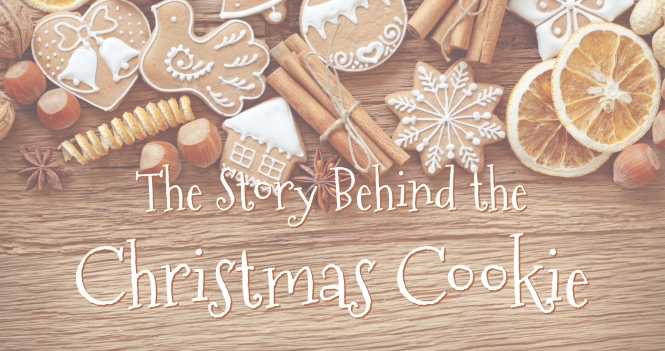
The first day of December brings with it a variety of seasonal favorites. Houses along the street shimmer with newly-hanged lights, radio stations begin their 24-hour seasonal soundtracks, and people all over the country scour the internet for delicious and different Christmas cookie recipes. While we have found a couple unique cookie lists that we’ll share with you in a minute, we thought it would be fun to first share a little history of the Christmas cookie.
There’s some debate about whether the story begins by accident or on purpose, so we’ll present both theories and let you be the judge. Some historians believe cookies were the likely result of early (we’re talking Neolithic Era) humans spilling grain paste on the rocks around a cooking fire. Talk about a happy accident. Others believe cookies originated as small, tester cakes, put into a hot oven to determine if it was the correct temperature to bake a full-sized cake.
No matter the original origin story, there’s no debate that sweet baked goods have been found at winter solstice festivals and celebrations for thousands of years, predating the holiday we know as Christmas. As with many modern holidays, Christmas formed as a convenient melding of pagan and Christian traditions that occurred around the same time of year. People naturally acknowledged the arrival of winter with the killing of animals that would be a burden on the grain supply through the famine of winter. With an abundance of fresh meat and the flowing of mead that had been set to ferment in the spring, the only thing missing from the party was dessert!
 The traditional flavors of Christmas cookies are spicy, nutty, and fruity. These types of ingredients were used in the Middle Ages when cooks prepared celebratory cakes of cinnamon, ginger, pepper, almonds, and dried fruit. It wasn’t until lebkuchen, or gingerbread, made its way from Germany to Queen Elizabeth I that the Christmas cookie began to take shape. At this point in time, Christmas had already eclipsed the solstice as the most popular winter celebration, so it was no surprise when Elizabeth I wished to honor her courtiers with the gift of having her cooks fashion ginger cookies in their likeness. This is how gingerbread men became a Christmas staple.
The traditional flavors of Christmas cookies are spicy, nutty, and fruity. These types of ingredients were used in the Middle Ages when cooks prepared celebratory cakes of cinnamon, ginger, pepper, almonds, and dried fruit. It wasn’t until lebkuchen, or gingerbread, made its way from Germany to Queen Elizabeth I that the Christmas cookie began to take shape. At this point in time, Christmas had already eclipsed the solstice as the most popular winter celebration, so it was no surprise when Elizabeth I wished to honor her courtiers with the gift of having her cooks fashion ginger cookies in their likeness. This is how gingerbread men became a Christmas staple.
Soon recipes for cookies were cropping up in cookbooks all over Europe. The Dutch brought the tradition of Christmas cookies with them to America in the early 1600s. While most recipes from the sixteen and seventeen hundreds produce rudimentary, super-crunchy biscuits sprinkled with savory spices, Americans gave them delightfully whimsical names, like plunkets, jumbles, and cry-babies. The recipes for these crunchy confections often warn bakers that the cookies are best enjoyed up to a week after baking, only after the humidity of a cellar has made them more palatable.
It wasn’t until cookie cutters were imported from Germany in the late 1800s that people were able to create cookies in elaborate shapes. The cutters were originally intended to make Christmas ornaments using inedible dough. However, it didn’t take long for people to start pressing them into cookie dough, and the cut-out cookie was formed.

Just as the origin of cookies has more than one possible story, the tradition of putting out cookies for Santa also has more than one starting point. Norse tradition has had people putting out food for Odin’s eight-legged horse, Sleipner, for thousands of years. Some believe the act of leaving cookies for St. Nick is in homage to the generosity of the actual Saint Nicholas, who spent his life helping people and feeding children in need. Still others state that the tradition gained traction during the Great Depression in the United States, when parents sought to teach children the importance of showing gratitude for their gifts, no matter how simple or small.
Christmas cookie swaps have origins dating as far back as WWI, but historians believe the swaps mentioned in literature from that time were more like bake sales today. The true holiday cookie exchange is often attributed to the Erwin Group, a division of the Syracuse Home Bureau, dating back to Syracuse, New York in 1936. If you plan on mixing up your own batch of dough and participating in one of these iconic Christmas cookie traditions, consider bringing your treats in one of our cookie carriers, so they’ll stay safe and presentable on the way. If you’re making bars, we have the perfect bake-and-take solution.
Whether you get together with friends to trade recipes and share humorous stories of your baking mishaps, or if you low-key leave a plate of Oreos for Santa on Christmas Eve, there’s no denying Christmas cookies have become a tasty staple of the holiday season.

To see cookies inspired by (almost) every state in America, click here.
To see a holiday Cookie Calendar featuring 25 unique recipes, click here.








